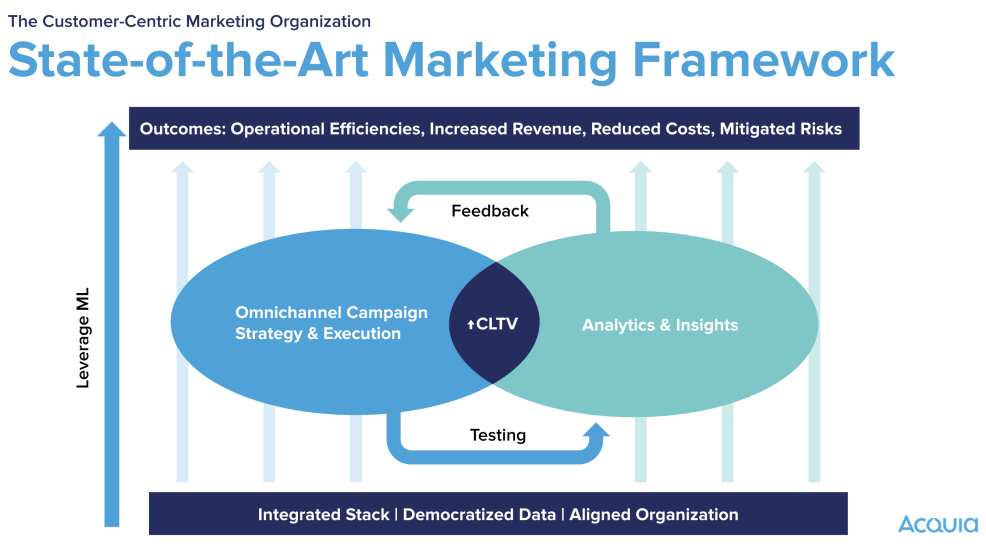
How to Become a Leading Customer-Centric Organization

From leading scholars to analysts, customer-centric marketing is seen as one of the key drivers of an organization’s success today. Reaching that goal demands investing in technology that can transform a product-centric business to one that prioritizes the customer at every touchpoint.
Indeed, MarTech Alliance reports that companies’ second-biggest barrier to delivering a great customer experience (CX) is that they lack the right tech solutions. And the primary barrier? A workforce with weak tech and data skills.
But both obstacles can be overcome, and we believe that customer data platforms (CDPs) and great partners are the solution. Often confused with DMPs, CRMs, and data lakes, a CDP goes beyond their operational functions to unify customer data and, powered by machine learning (ML), generates rich insights that lead to return on investment (ROI). Just look at results from brands like J.Crew and lululemon.
So, as the creators of pioneering predictive marketing tool Acquia CDP — we debuted it way back in 2005 — we can share lessons and observations from 17+ years of experience and 200+ implementation and transformation projects. We’ll look at:
- How CDPs are key enablers for brands at different stages of marketing maturity,
- How they present a simple framework for running a customer-centric organization, and
- How to identify steps for transforming your business.
As you seek to become a truly customer-centric and data- and insights-driven organization, a CDP naturally facilitates decisions and activities spanning business units from marketing to service, purchasing, and other departments. This is a no-brainer claim when you consider a CDP’s value: unifying critical customer data as well as creating and sustaining a single view of your customers. It sounds straightforward, but this valuable function shouldn’t be minimized.
The first step is understanding your organizational maturity.
The 3 stages of marketing maturing explained
To understand which stage you occupy, you must look at the state of your data, organization, employee experience (EX), and CX.
The brand- or product-centric stage
In this old school approach to marketing, communications are often dictated by brand- or product-driven tactics. The needs of the customer are subsumed, so the CX is disjointed. Campaigns are executed for the wrong reasons. For example, you might have excess stock of a certain product, so you launch a blanket discounting campaign. Personalization is disregarded, and all customers receive batch-and-blast communications.
Then, from a tech perspective, databases are siloed. Without a central customer database, tasks like pulling lists, tracking KPIs, and other business reporting is both cumbersome and slow.
In this stage, marketing teams don’t have self-service access to data. They have to reach out to other departments — IT, insights, analytics — or external agencies like marketing service providers (MSPs) in most of their daily operations. Automation is a joke, because most processes are designed around one-off custom requests. Your colleagues spend entire days on mundane tasks like coordinating other teams, submitting and tracking requests, or validating files — what does this sacrifice? Strategic initiatives; departmental goals fall by the wayside.
The transformational stage
Here, we start to see a metamorphosis with the incorporation of a CDP into the martech stack. The central database of clean customer data gradually becomes an empowering tool across the organization, connecting information from various technologies. From CRMs, ERPs, and loyalty programs to campaign, engagement, and privacy software, the CDP gathers data to produce actionable, 360° profiles of individual customers. Soon, data is democratized, simultaneously promoting departmental independence and organizational alignment because everyone’s working from the same, consistent data foundation.
And, with departmental goals better aligned, automation and access result in efficiencies that allow staff to focus on strategic initiatives that drive customer lifetime value (CLTV) and loyalty.
The customer-centric stage
The customer-centric stage is like the state of California: golden. Every customer touchpoint is personalized, and organizational goals revolve around a unified database, giving all parties that work with customers direct access, be they your marketing comms team, call center, in-store clienteling applications, or kiosks.
The employee experience also improves because KPIs are clearly articulated and tracked with the help of business analytics and intelligence tools.
Company-wide, advanced tools like machine learning models enhance data and decisions so business processes can be truly optimized. Everyone’s accountable, because performance is tracked through data. It’s a pretty great stage to be in, organizationally speaking.
The state-of-the-art marketing framework
But how do those stages of marketing maturity fit into a framework exemplified by leading organizations?
The framework begins to take shape when we consider the ultimate business outcomes: operational efficiencies, increased revenue, reduced costs, and mitigated risks. At Acquia, we not only strive to reach those outcomes, we also seek to quantify them and to measure our own performance in helping customers meet their goals.
For the visual thinkers among us, below is a diagram of the framework we use to get there. The unified database and democratization of data supply a solid base from which an organization can design a truly omnichannel, customer-centric experience. Your marketing and service strategy needs to constantly evolve, and insights derived from a CDP on customer needs should inform that evolution.
You start to see how execution and analytics are intertwined, right? When that double helix is in place, your organizational DNA displays a continuous testing and feedback loop that ultimately increases CLTV and drives the business outcomes.

Another important piece of the puzzle is ML capabilities. As more data sources integrate into the unified database, its volume and complexity naturally increases. You need a CDP with a strong ML function to help optimize business decisions. Any CDP you fold into your martech stack should have it.
Steps to digital transformation
We’ve reviewed the stages of marketing maturity, as well as the framework that can move you towards customercentricity. Now let’s look at how you actually transform your business.
Step 1: Eliminate silos and create a 360° customer view
We’ve mentioned this before, but it bears repeating: A central database that gets rid of data silos is compulsory. Not only does it offer a consistent view of customer records, it’s the foundation of the framework we just discussed. Your CDP should have advanced capabilities around unifying data, and it should be able to resolve identities using both fuzzy and exact rules that can be configured to meet enterprise needs.
Step 2: Make data consistent and available across departments to support personalization
Having a centralized database isn’t enough. You need to also ensure that everyone in your organization has access to it — this is where CDPs are distinct from other solutions that claim to present a 360° customer view. (No, CRMs and DMPs don’t do this.)
We realize that marketing, customer service, business intelligence, and other departments likely already use a variety of applications, so choose a CDP that can integrate with virtually any of them. (Acquia CDP does.) Integration will enhance those databases and enable the personalization of customer experiences across all channels.
Step 3: Design an omnichannel strategy
Once you’ve made the data widely available to your organization, design a customer experience strategy that captures all engagement points. Otherwise, you miss critical opportunities to delight your customers.
CLTV is a key metric that you need to focus on at this step. Not all customers are equally valuable to your brand, and not all of them want the same level of service or engagement. Your overall strategy should acknowledge this fact.
Step 3: Analyze, test, measure, iterate, and improve
Finally, teams should constantly measure activity, test new ideas, and improve their strategy. It’s why the BI functionality is so important. Without it, there’s simply no way to successfully and accurately measure KPIs and to understand whether desired outcomes have been met.
Next steps: Build on the foundation
If CDPs are the foundation of customer centricity (and they are), then organizations can build on them through strong partnerships.
Through free workshops tailored to your organization, Acquia can help you create a business plan for your digital transformation by identifying desired outcomes that align with your business strategy. And if you need help developing a prioritized roadmap with quantified benefits and a clear path to success, we can assist with that too.
It’s no secret that brands that don’t take full advantage of their customer data lose their most valuable customers to competitors every day. Why not reach out to learn more about our digital strategy services? No better time to initiate your transformation than today.


